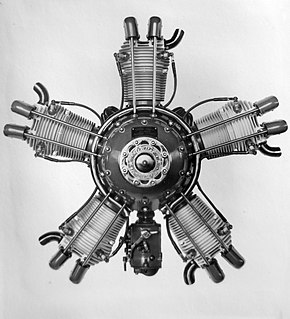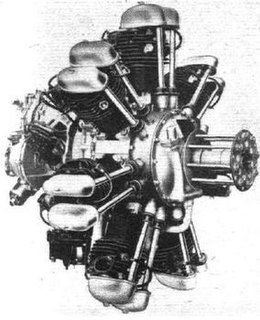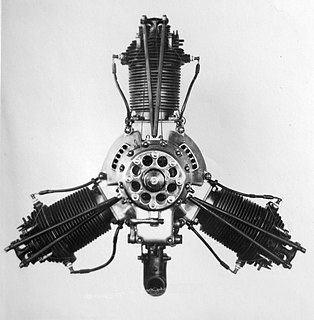| Atlas | |
|---|---|
 | |
| Type | Nine-cylinder radial engine |
| National origin | Czechoslovakia |
| Manufacturer | Walter Engines |
| First run | 1930 |
The Walter Atlas was a nine-cylinder, air-cooled, radial engine for aircraft use built in Czechoslovakia in the early 1930s.
| Atlas | |
|---|---|
 | |
| Type | Nine-cylinder radial engine |
| National origin | Czechoslovakia |
| Manufacturer | Walter Engines |
| First run | 1930 |
The Walter Atlas was a nine-cylinder, air-cooled, radial engine for aircraft use built in Czechoslovakia in the early 1930s.
The Atlas was the largest capacity and most powerful radial engine design developed by the Walter company. The engine was an attempt at high power output by using a much larger bore size than company's previous range. The engine was test run in spring 1930, encountering problems with cooling and operation. [1]
The engine appeared at the Paris Aerosalon in December of that year. The engine did not attract any customers, further development was cancelled in 1931 and the company moved to producing licensed versions of the Bristol Mercury, Pegasus and Gnome-Rhône 14M. [1]

Data fromNěmeček and Letecvi. [1] [2]
Related lists
The Aquila was a nine-cylinder single-row radial aircraft engine designed by the Bristol Engine Company starting in 1934. A sleeve valve engine, its basic design was developed from the Bristol Perseus. The Aquila was never used in production, but further developments led to the Bristol Hercules, Bristol Taurus, and Bristol Centaurus.

The Armstrong Siddeley Leopard was a British 14-cylinder twin-row air-cooled radial aero engine developed in 1927 by Armstrong Siddeley. It was the most powerful radial engine in the world when introduced.
The Armstrong Siddeley Panther was a 27-litre 14-cylinder twin-row air-cooled radial aero engine developed by Armstrong Siddeley. It was originally named the Jaguar Major.

The Armstrong Siddeley Lynx is a British seven-cylinder aero engine developed by Armstrong Siddeley. Testing began in 1920 and 6,000 had been produced by 1939. In Italy Alfa Romeo built a 200 horsepower (150 kW) licensed version of this engine named the Alfa Romeo Lynx.
The Bristol Draco was an air-cooled nine-cylinder radial engine from the British manufacturer Bristol Aeroplane Company. It was essentially a version of their famous Pegasus converted to use a fuel injection system.

The Walter Venus was a seven-cylinder, air-cooled, radial engine for aircraft use, built in Czechoslovakia in the late 1920s.

The Walter Vega was a five-cylinder, air-cooled, radial engine for aircraft use, built in Czechoslovakia in the late 1920s.

The Armstrong Siddeley Tiger was a British 14-cylinder air-cooled aircraft radial engine developed by Armstrong Siddeley in the 1930s from their Jaguar engine. The engine was built in a number of different versions but performance and dimensions stayed relatively unchanged. The Tiger VIII was the first British aircraft engine to use a two-speed supercharger.
The Siemens-Halske Sh 22 was a nine-cylinder aircraft radial engine manufactured by Siemens & Halske in Germany in the 1930s. Following the reorganization of its manufacturer and change in military nomenclature, the engine became known as the Bramo 322.
The Jacobs R-830 or L-5 is a seven-cylinder, air-cooled, radial engine for aircraft manufactured in the United States, production started in 1935.

The Bristol Neptune was a seven-cylinder air-cooled radial engine developed in 1930. It had the same size cylinders as the earlier Mercury and Titan engines, 5.75 in (146 mm) x 6.5 in (165 mm) which gave a displacement of 1,182 cu in and produced a maximum of 320 horsepower (239 kW). The Neptune was effectively a seven-cylinder version of the Titan.

The Wolseley Aquarius I or A.R.7 was a British seven-cylinder, air-cooled radial aero engine that first ran in 1933, it was designed and built by Wolseley Motors. Intended for the military trainer aircraft market few were produced, as Wolseley withdrew from the aero engine market in 1936.

British Salmson aero-engines refers to a series of small French designed, air-cooled radial aero engine that were produced by British Salmson Aero Engines Ltd, under license from Société des Moteurs Salmson, in Great Britain during the late 1920s and 1930s.

The Walter Pollux is a Czechoslovakian nine-cylinder, air-cooled, radial engine, built by Walter Aircraft Engines for powering light aircraft and that first ran in 1936. The engine produces 240 kW (320 hp) at 1,800 rpm.

The Walter Bora was a Czechoslovakian nine-cylinder, air-cooled radial engine for powering light aircraft that was developed in the 1930s by Walter Aircraft Engines.

The Avia Rk.17 was a 9-cylinder radial aircraft engine, developed from the 7-cylinder Avia Rk.12, with a rated output of 270 kW (360 hp). The Rk.17 was one of Avia's own designs and was built in Czechoslovakia in the 1930s.

The Walter NZ 120 was a nine-cylinder, air-cooled, radial engine for aircraft use built in Czechoslovakia by Walter Aircraft Engines in the 1920s. Using common cylinders and parts from the NZ (Novák-Zeithammer) range of engines the NZ 120 produced up to 135 horsepower (99 kW).

The Fiat A.70 was an air cooled radial engine with seven cylinders developed by the Italian engineering company Fiat Aviazione in the 1930s. The engine powered a number of Italian light competition and prototype aircraft.

The Walter NZ 40 was an unsuccessful, three-cylinder, air-cooled, radial engine for aircraft use built in Czechoslovakia by Walter Aircraft Engines in the late-1920s.

The Walter Minor 12 was a 12-cylinder, air-cooled, V engine for aircraft use built in Czechoslovakia by Walter Aircraft Engines in the late-1930s.